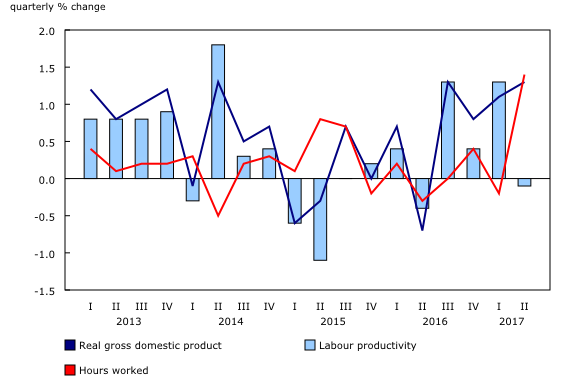Labour productivity, hourly compensation and unit labour cost, second quarter 2017
Archived Content
Information identified as archived is provided for reference, research or recordkeeping purposes. It is not subject to the Government of Canada Web Standards and has not been altered or updated since it was archived. Please "contact us" to request a format other than those available.
Released: 2017-09-06
Second quarter 2017
-0.1% 
(quarterly change)
Labour productivity edges down in the second quarter
Labour productivity of Canadian businesses edged down 0.1% in the second quarter following three consecutive quarters of growth. This decline followed a significant 1.3% increase in the first quarter.
The slight decrease in productivity in the second quarter reflects a recovery in hours worked after a quarter of decline, while growth in business output continued at a faster pace.
Real gross domestic product (GDP) of businesses rose 1.3% in the second quarter, up from 1.1% in the first quarter. This marked the third time in four quarters that GDP growth of businesses has been greater than 1.0%. As in the first quarter, growth was widespread in goods-producing and service-producing business industries. Only the agriculture and forestry sector posted a decline in production in the second quarter, falling for a third consecutive quarter.
GDP growth of businesses in the second quarter was accompanied by the largest increase in hours worked (+1.4%) since the fourth quarter of 2003 (+1.9%). Hours worked rose at a comparable pace in both goods-producing (+1.2%) and service-producing (+1.4%) businesses. They were up in every major industrial sector except agriculture and forestry (-1.3%), information and cultural industries (-0.8%) and utilities (-0.3%).
Service-producing businesses (-0.3%) were the largest contributor to the decline in productivity in the second quarter, partially offset by a 0.6% increase in goods-producing businesses.
In goods-producing businesses, utilities (+3.6%) was the only industrial sector with increased productivity in the second quarter. On the other hand, productivity decreased 1.9% in the mining, quarrying and oil and gas extraction sector, while agriculture and forestry (-0.3%), manufacturing (-0.2%) and construction (-0.1%) edged down.
Productivity in service-producing businesses fell for the first time since the third quarter of 2015. Despite increases in retail trade (+1.4%), information and cultural industries (+1.0%), wholesale trade (+0.9%) and finance and insurance (+0.9%), the other service industries posted declines, led by a notable decrease in real estate services (-2.3%).
In the United States, the labour productivity of businesses rose 0.2% in the second quarter, following a 0.2% decline in the previous quarter. The second quarter real GDP of American businesses (+0.8%) grew at a faster pace than the first quarter (+0.3%), while hours worked (+0.6%) increased at a similar pace (+0.5%).
A second consecutive decline in unit labour costs
For Canadian businesses, labour costs per unit of output fell for the second straight quarter, down 0.8% in the second quarter.
The decrease in unit labour costs primarily reflected a decline in the average compensation per hour worked (-0.9%), while productivity was stable. This was the first decrease in hourly compensation since the third quarter of 2015 (-0.4%).
Hourly compensation fell in goods-producing (-1.4%) and service-producing (-0.6%) businesses in the second quarter. Utilities (+2.2%), information and cultural industries (+0.7%), transportation and warehousing services (+0.4%) and finance and insurance (+0.1%) increased, while declines were widespread throughout the other industries. Mining, quarrying and oil and gas extraction (-4.1%), real estate services (-2.4%) and construction (-1.9%) posted the most notable declines.
Expressed in US dollars, unit labour costs of Canadian businesses fell 2.4% in the second quarter, following a 0.5% increase in the previous quarter. After rising 0.8% in the first quarter, the average value of the Canadian dollar relative to the US dollar decreased 1.6% in the second quarter.
In comparison, unit labour costs of American businesses increased 0.2%, following a strong 1.4% gain in hourly compensation the first quarter.
Note to readers
Revisions
With this release on labour productivity and related measures, data were revised back to the first quarter of 2017 at the aggregate level and to the first quarter of 2016 at the industry level.
Productivity measure
The term productivity in this release refers to labour productivity. For the purposes of this analysis, labour productivity and related variables cover the business sector only.
Labour productivity is a measure of real gross domestic product (GDP) per hour worked.
Unit labour cost is defined as the cost of workers' wages and benefits per unit of real GDP.
All the growth rates reported in this release are rounded to one decimal place. They are calculated with index numbers rounded to three decimal places, which are now available on CANSIM.
All necessary basic variables for productivity analyses (such as hours worked, employment, output and compensation) are seasonally adjusted. For information on seasonal adjustment, see Seasonally adjusted data – Frequently asked questions.
Next release
Labour productivity, hourly compensation and unit labour cost data for the third quarter will be released on December 6.
Products
The System of Macroeconomic Accounts module, accessible from the Browse by key resource module of our website, features an up-to-date portrait of national and provincial economies and their structure.
The Methodological Guide: Canadian System of Macroeconomic Accounts (13-607-X) is available.
The User Guide: Canadian System of Macroeconomic Accounts (13-606-G) is also available. This publication will be updated to maintain its relevance.
Contact information
For more information, or to enquire about the concepts, methods or data quality of this release, contact us (toll-free 1-800-263-1136; 514-283-8300; STATCAN.infostats-infostats.STATCAN@canada.ca) or Media Relations (613-951-4636; STATCAN.mediahotline-ligneinfomedias.STATCAN@canada.ca).
- Date modified:


